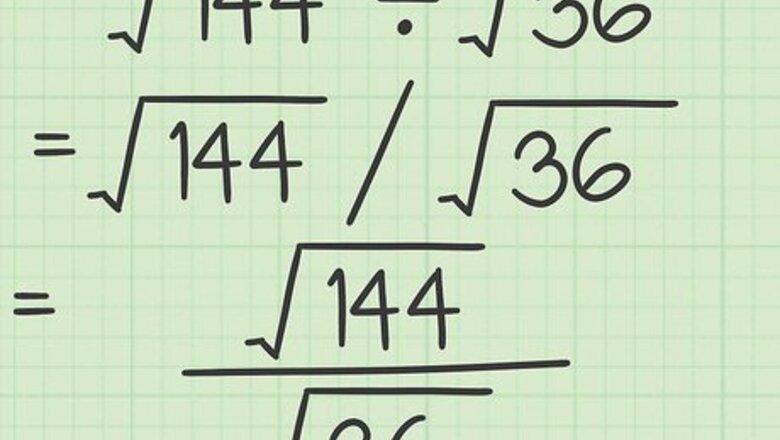
views
Dividing Radicands
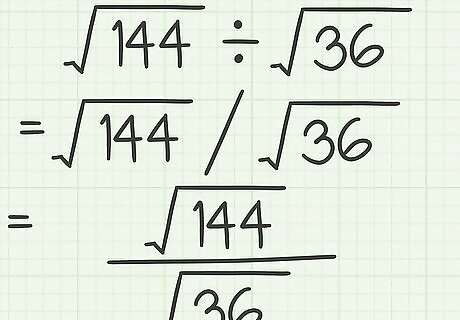
Set up a fraction. If your expression is not already set up like a fraction, rewrite it this way. This makes it easier to follow all the necessary steps when dividing by a square root. Remember that a fraction bar is also a division bar. For example, if you are calculating 144 ÷ 36 {\displaystyle {\sqrt {144}}\div {\sqrt {36}}} {\sqrt {144}}\div {\sqrt {36}}, rewrite the problem like this: 144 36 {\displaystyle {\frac {\sqrt {144}}{\sqrt {36}}}} {\frac {{\sqrt {144}}}{{\sqrt {36}}}}.
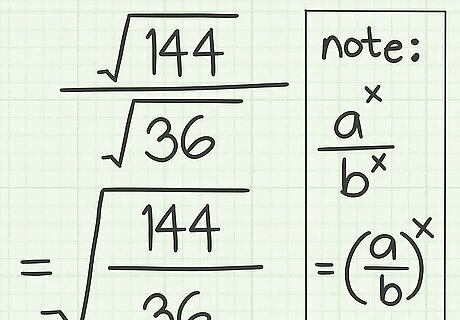
Use one radical sign. If your problem has a square root in the numerator and denominator, you can place both radicands under one radical sign. (A radicand is a number under a radical, or square root, sign.) This will simplify the simplifying process. For example, 144 36 {\displaystyle {\frac {\sqrt {144}}{\sqrt {36}}}} {\frac {{\sqrt {144}}}{{\sqrt {36}}}} can be rewritten as 144 36 {\displaystyle {\sqrt {\frac {144}{36}}}} {\sqrt {{\frac {144}{36}}}}.
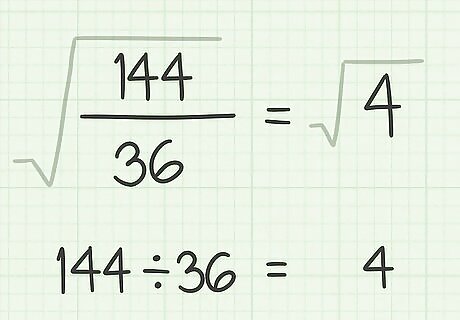
Divide the radicands. Divide the numbers as you would any whole number. Make sure to place their quotient under a new radical sign. For example, 144 36 = 4 {\displaystyle {\frac {144}{36}}=4} {\frac {144}{36}}=4, so 144 36 = 4 {\displaystyle {\sqrt {\frac {144}{36}}}={\sqrt {4}}} {\sqrt {{\frac {144}{36}}}}={\sqrt {4}}.
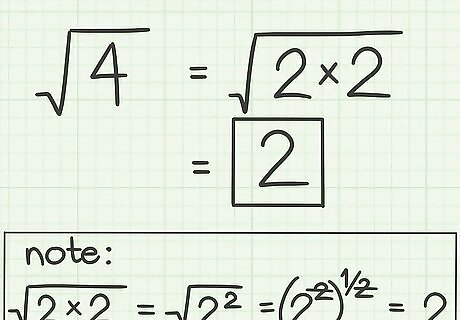
Simplify, if necessary. If the radicand is a perfect square, or if one of its factors is a perfect square, you need to simplify the expression. A perfect square is the product of a whole number multiplied by itself. For example, 25 is a perfect square, since 5 × 5 = 25 {\displaystyle 5\times 5=25} 5\times 5=25. For example, 4 is a perfect square, since 2 × 2 = 4 {\displaystyle 2\times 2=4} 2\times 2=4. Thus: 4 {\displaystyle {\sqrt {4}}} {\sqrt {4}} = 2 × 2 {\displaystyle ={\sqrt {2\times 2}}} ={\sqrt {2\times 2}} = 2 {\displaystyle =2} =2So, 144 36 = 4 = 2 {\displaystyle {\frac {\sqrt {144}}{\sqrt {36}}}={\sqrt {4}}=2} {\frac {{\sqrt {144}}}{{\sqrt {36}}}}={\sqrt {4}}=2.
Factoring Radicands
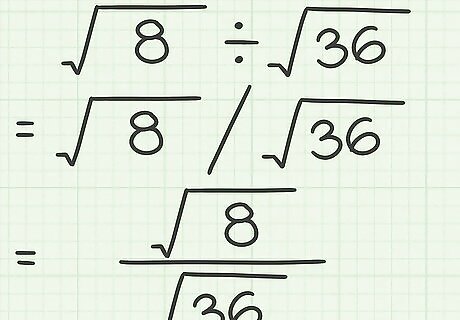
Express the problem as a fraction. You will likely already see the expression written this way. If not, change it. Solving the problem as a fraction makes it easier to follow all the necessary steps, especially when factoring the square roots. Recall that a fraction bar is also a division bar. For example, if you are calculating 8 ÷ 36 {\displaystyle {\sqrt {8}}\div {\sqrt {36}}} {\sqrt {8}}\div {\sqrt {36}}, rewrite the problem like this: 8 36 {\displaystyle {\frac {\sqrt {8}}{\sqrt {36}}}} {\frac {{\sqrt {8}}}{{\sqrt {36}}}}.
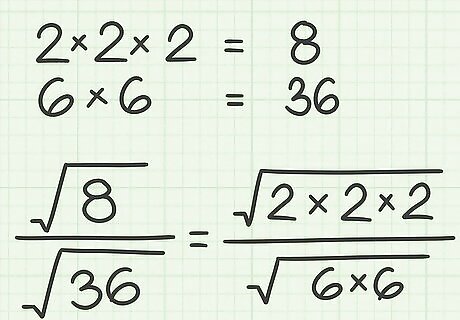
Factor each radicand. Factor the number as you would any whole number. Keep the factors under the radical signs. For example: 8 36 = 2 × 2 × 2 6 × 6 {\displaystyle {\frac {\sqrt {8}}{\sqrt {36}}}={\frac {\sqrt {2\times 2\times 2}}{\sqrt {6\times 6}}}} {\frac {{\sqrt {8}}}{{\sqrt {36}}}}={\frac {{\sqrt {2\times 2\times 2}}}{{\sqrt {6\times 6}}}}
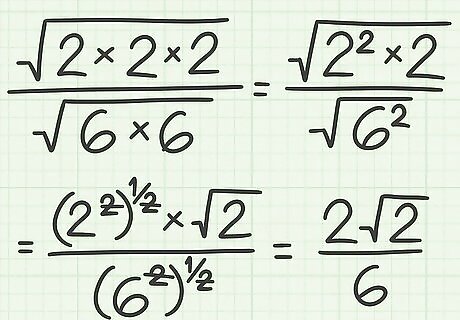
Simplify the numerator and denominator of the fraction. To simplify a square root, pull out any factors that make a perfect square. A perfect square is the result of a whole number multiplied by itself. The factor will now become a coefficient outside of the square root. For example: 2 × 2 × 2 6 × 6 {\displaystyle {\frac {\sqrt {{\cancel {2\times 2\times }}2}}{\sqrt {\cancel {6\times 6}}}}} {\frac {{\sqrt {{\cancel {2\times 2\times }}2}}}{{\sqrt {{\cancel {6\times 6}}}}}} 2 2 6 {\displaystyle {\frac {2{\sqrt {2}}}{6}}} {\frac {2{\sqrt {2}}}{6}}So, 8 36 = 2 2 6 {\displaystyle {\frac {\sqrt {8}}{\sqrt {36}}}={\frac {2{\sqrt {2}}}{6}}} {\frac {{\sqrt {8}}}{{\sqrt {36}}}}={\frac {2{\sqrt {2}}}{6}}
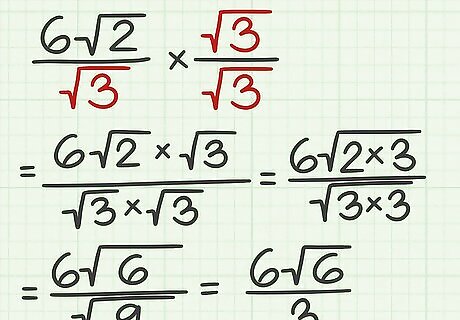
Rationalize the denominator, if necessary. As a rule, an expression cannot have a square root in the denominator. If your fraction has a square root in the denominator, you need to rationalize it. This means to cancel out the square root in the denominator. To do this, multiply the numerator and denominator of the fraction by the square root you need to cancel. For example, if your expression is 6 2 3 {\displaystyle {\frac {6{\sqrt {2}}}{\sqrt {3}}}} {\frac {6{\sqrt {2}}}{{\sqrt {3}}}}, you need to multiply the numerator and denominator by 3 {\displaystyle {\sqrt {3}}} {\sqrt {3}} to cancel the square root in the denominator: 6 2 3 × 3 3 {\displaystyle {\frac {6{\sqrt {2}}}{\sqrt {3}}}\times {\frac {\sqrt {3}}{\sqrt {3}}}} {\frac {6{\sqrt {2}}}{{\sqrt {3}}}}\times {\frac {{\sqrt {3}}}{{\sqrt {3}}}} = 6 2 × 3 3 × 3 {\displaystyle ={\frac {6{\sqrt {2}}\times {\sqrt {3}}}{{\sqrt {3}}\times {\sqrt {3}}}}} ={\frac {6{\sqrt {2}}\times {\sqrt {3}}}{{\sqrt {3}}\times {\sqrt {3}}}} = 6 6 9 {\displaystyle ={\frac {6{\sqrt {6}}}{\sqrt {9}}}} ={\frac {6{\sqrt {6}}}{{\sqrt {9}}}} = 6 6 3 {\displaystyle ={\frac {6{\sqrt {6}}}{3}}} ={\frac {6{\sqrt {6}}}{3}}.
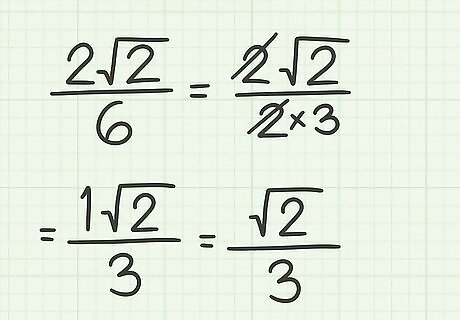
Simplify further, if necessary. Sometimes you will be left with coefficients that can be simplified, or reduced. Simplify the whole numbers in the numerator and denominator as you would simplify any fraction. For example, 2 6 {\displaystyle {\frac {2}{6}}} {\frac {2}{6}} reduces to 1 3 {\displaystyle {\frac {1}{3}}} {\frac {1}{3}}, so 2 2 6 {\displaystyle {\frac {2{\sqrt {2}}}{6}}} {\frac {2{\sqrt {2}}}{6}} reduces to 1 2 3 {\displaystyle {\frac {1{\sqrt {2}}}{3}}} {\frac {1{\sqrt {2}}}{3}}, or simply 2 3 {\displaystyle {\frac {\sqrt {2}}{3}}} {\frac {{\sqrt {2}}}{3}}.
Dividing Square Roots with Coefficients
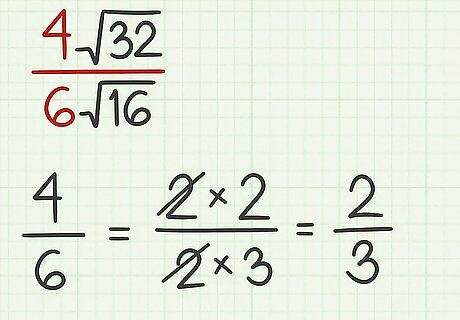
Simplify the coefficients. These are the numbers outside of the radical sign. To simplify them, divide or reduce, ignoring the square roots for now. For example, if you are calculating 4 32 6 16 {\displaystyle {\frac {4{\sqrt {32}}}{6{\sqrt {16}}}}} {\frac {4{\sqrt {32}}}{6{\sqrt {16}}}}, you would first simplify 4 6 {\displaystyle {\frac {4}{6}}} {\frac {4}{6}}. The numerator and denominator can both be divided by a factor of 2. So, you can reduce: 4 6 = 2 3 {\displaystyle {\frac {4}{6}}={\frac {2}{3}}} {\frac {4}{6}}={\frac {2}{3}}.
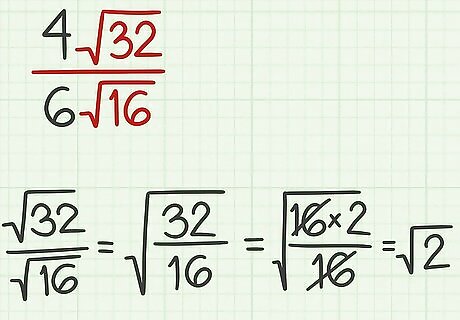
Simplify the square roots. If the numerator is evenly divisible by the denominator, simply divide the radicands. If not, simplify each square root as you would any square root. For example, since 32 is evenly divisible by 16, you can divide the square roots: 32 16 = 2 {\displaystyle {\sqrt {\frac {32}{16}}}={\sqrt {2}}} {\sqrt {{\frac {32}{16}}}}={\sqrt {2}}.
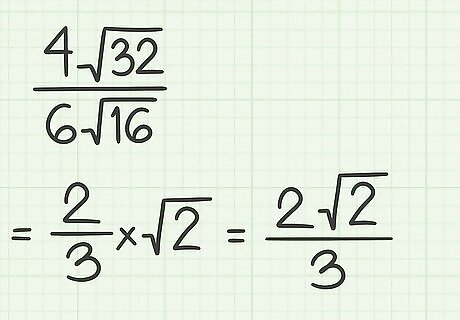
Multiply the simplified coefficient(s) by the simplified square root. Remember that you cannot have a square root in a denominator, so when multiplying a fraction by a square root, place the square root in the numerator. For example, 2 3 × 2 = 2 2 3 {\displaystyle {\frac {2}{3}}\times {\sqrt {2}}={\frac {2{\sqrt {2}}}{3}}} {\frac {2}{3}}\times {\sqrt {2}}={\frac {2{\sqrt {2}}}{3}}.
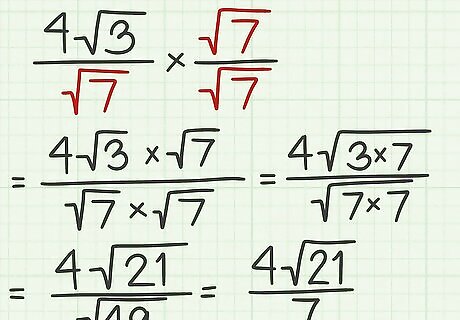
Cancel the square root in the denominator, if necessary. This is called rationalizing the denominator. As a rule, an expression cannot have a square root in the denominator. To rationalize the denominator, multiply the numerator and denominator by the square root you need to cancel. For example, if your expression is 4 3 2 7 {\displaystyle {\frac {4{\sqrt {3}}}{2{\sqrt {7}}}}} {\frac {4{\sqrt {3}}}{2{\sqrt {7}}}}, you need to multiply the numerator and denominator by 7 {\displaystyle {\sqrt {7}}} {\sqrt {7}} to cancel the square root in the denominator: 4 3 7 × 7 7 {\displaystyle {\frac {4{\sqrt {3}}}{\sqrt {7}}}\times {\frac {\sqrt {7}}{\sqrt {7}}}} {\frac {4{\sqrt {3}}}{{\sqrt {7}}}}\times {\frac {{\sqrt {7}}}{{\sqrt {7}}}} = 4 3 × 7 7 × 7 {\displaystyle ={\frac {4{\sqrt {3}}\times {\sqrt {7}}}{{\sqrt {7}}\times {\sqrt {7}}}}} ={\frac {4{\sqrt {3}}\times {\sqrt {7}}}{{\sqrt {7}}\times {\sqrt {7}}}} = 4 21 49 {\displaystyle ={\frac {4{\sqrt {21}}}{\sqrt {49}}}} ={\frac {4{\sqrt {21}}}{{\sqrt {49}}}} = 4 21 7 {\displaystyle ={\frac {4{\sqrt {21}}}{7}}} ={\frac {4{\sqrt {21}}}{7}}
Dividing by a Binomial with a Square Root
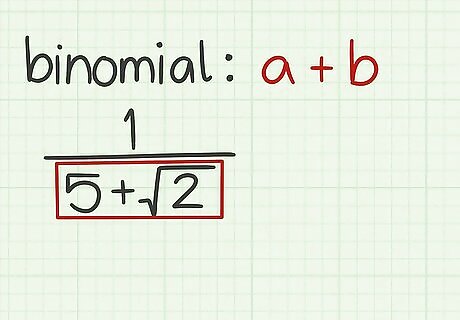
Determine that you have a binomial in the denominator. The denominator will be the number in the problem you are dividing by. A binomial is a two-termed polynomial. This method only applies to division of square roots involving a binomial. For example, if you are calculating 1 5 + 2 {\displaystyle {\frac {1}{5+{\sqrt {2}}}}} {\frac {1}{5+{\sqrt {2}}}}, you have a binomial in the denominator, since 5 + 2 {\displaystyle 5+{\sqrt {2}}} 5+{\sqrt {2}} is a two-termed polynomial.
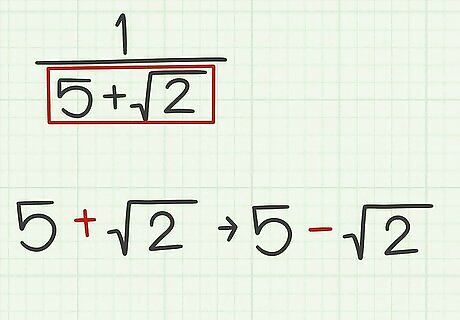
Find the conjugate of the binomial. Conjugate pairs are binomials that have the same terms, but opposite operations. Using a conjugate pair will allow you to cancel the square root in the denominator. For example, 5 + 2 {\displaystyle 5+{\sqrt {2}}} 5+{\sqrt {2}} and 5 − 2 {\displaystyle 5-{\sqrt {2}}} 5-{\sqrt {2}} are conjugate pairs, since they have the same terms but opposite operations.

Multiply the numerator and denominator by the denominator’s conjugate. Doing this will allow you to cancel the square root, because the product of a conjugate pair is the difference of the square of each term in the binomial. That is, ( a − b ) ( a + b ) = a 2 − b 2 {\displaystyle (a-b)(a+b)=a^{2}-b^{2}} (a-b)(a+b)=a^{{2}}-b^{{2}}. For example: 1 5 + 2 {\displaystyle {\frac {1}{5+{\sqrt {2}}}}} {\frac {1}{5+{\sqrt {2}}}} = 1 ( 5 − 2 ) ( 5 + 2 ) ( 5 − 2 ) {\displaystyle ={\frac {1(5-{\sqrt {2}})}{(5+{\sqrt {2}})(5-{\sqrt {2}})}}} ={\frac {1(5-{\sqrt {2}})}{(5+{\sqrt {2}})(5-{\sqrt {2}})}} = 5 − 2 ( 5 2 − ( 2 ) 2 {\displaystyle ={\frac {5-{\sqrt {2}}}{(5^{2}-({\sqrt {2}})^{2}}}} ={\frac {5-{\sqrt {2}}}{(5^{{2}}-({\sqrt {2}})^{{2}}}} = 5 − 2 25 − 2 {\displaystyle ={\frac {5-{\sqrt {2}}}{25-2}}} ={\frac {5-{\sqrt {2}}}{25-2}} = 5 − 2 23 {\displaystyle ={\frac {5-{\sqrt {2}}}{23}}} ={\frac {5-{\sqrt {2}}}{23}}Thus, 1 5 + 2 = 5 − 2 23 {\displaystyle {\frac {1}{5+{\sqrt {2}}}}={\frac {5-{\sqrt {2}}}{23}}} {\frac {1}{5+{\sqrt {2}}}}={\frac {5-{\sqrt {2}}}{23}}.




















Comments
0 comment